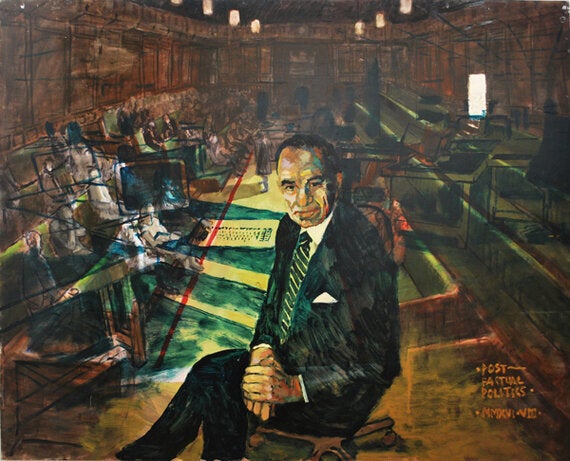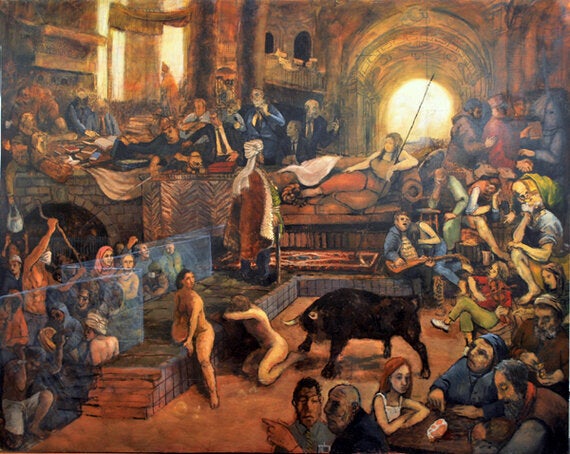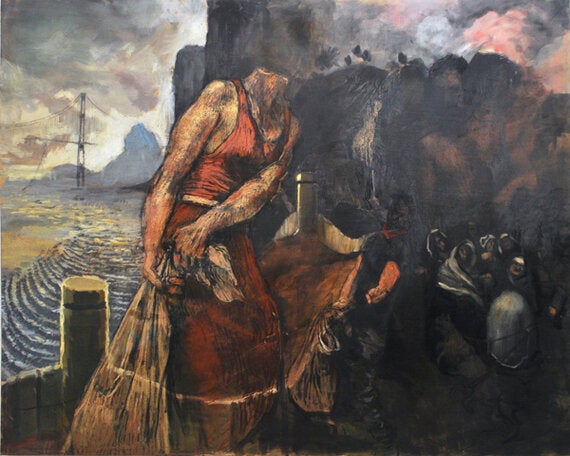The first time I came across Michael Chance's work, his paintings were mainly of figureless landscapes, often bleak, apocalyptic even, laden with political meaning and impressive for it. Yet, he became frustrated by the shallowness of the interpretation that most seemed to have of them, that missed the inherent connotations.
His new show, Body Politic, is so charged with political references that even the most blinkered could not fail to spot some of the allegories and symbols.
As if in reaction, figures galore now populate and activate his large canvases (all 5 foot by 4) made in oil, charcoal and pastel, as he seeks to extract some meaning to the chaos and complexity of our modern world.

The only recognisable figure in the exhibition is that of Rupert Murdoch, at the centre of Post Factual Politics (above). The painting was inspired by the vote in the House of Commons that sanctioned the bombing of Syria which he watched on a small video screen that gave him an acute sense of detachment from the political process. The MPs are faceless - they're replaceable - yet Murdoch's influence has been a constant throughout Chance's lifetime.
"Murdoch is representative of what I've labelled as Post Factual Politics, politics that's not based on facts any longer, maybe never was, but the major decisions that are being made and how they're framed, whether it's in parliament or in a referendum, are being made fundamentally on the basis of misinformation on both sides."
Chance is a great admirer of the so-called Masters of Suspicion such as Marx, Freud and Nietzsche who examine the underlying causes that drive the surface appearance of events. He loves too the Baroque aesthetic with its sense of dark drama and complexity. As one who has studied film as well as fine art, he is inspired too by the British film director Peter Greenaway, whose lavish sets and sense of the noir, also harks back to the Baroque.

All these strains come together in the highly ambitious The Temple Corrupted (above). As in one of Breughel's villages, all society is laid bare in a single place. To the right are the "haves" with the symbolic space to enjoy their freedoms though they take no notice of the rampaging bull. Opposite the "have-nots" are restricted by a barrier while above them the religious reference to the work's title symbolises all manner of modern capitalism. Despite the obvious themes, Chance does not see himself primarily as a polemicist.
"My work comes primarily from an artistic urge rather than a didactic one of wanting to preach or anything. The urge is from the pleasure of sculpting figures out of paint."

The current major world issue of migration exercises many contemporary artists. Chance's take is seen in the haunting depiction that is The Wall (above) inspired by a Goya painting in which a wall blocks off the coastline. It envisages a future scenario in which all of our borders are militarised and walled off like this. Ghostly figures inhabit the wall itself and the commanding, headless figure of the migrant contrasts with the huddle of scared people within the destination who react in a xenophobic way.
"I wanted the headless figure to be one of strength that shows the kind of wrenching difficulty it takes to move oneself and one's family across borders. So she's going across the wall. Once you have a head you have a face, once you have a face you have the implication of a personality and I didn't want a particular but a general representation of a particular force."
Chance used his partner and fellow artist Rachel Mercer as the model for the migrant. In a much more scaled-down way, the couple has experienced the powerlessness and anonymity involved in trying to establish an artistic practice in the highly competitive and expensive arena that is London.
They're surviving so far by using their living quarters as both a gallery and a studio to keep down costs and by turning out high-quality, thoughtful and provocative work.
Body Politic is showing at the Mercer Chance Gallery, 253 Hoxton Street, London N1 5LG until 19 September.
The images are used with the permission of the artist.